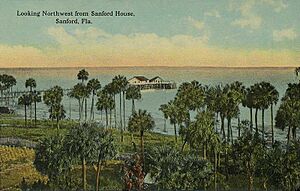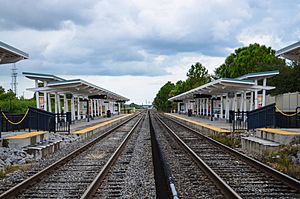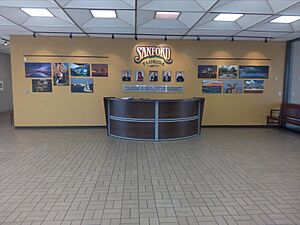Sanford, Florida facts for kids
Quick facts for kids
Sanford, Florida
|
|||
|---|---|---|---|
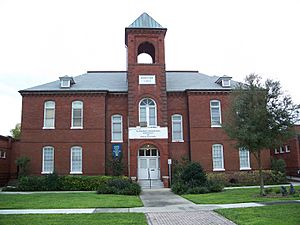
The Sanford Grammar School in January 2007
|
|||
|
|||
| Nickname(s):
"Celery City"
|
|||
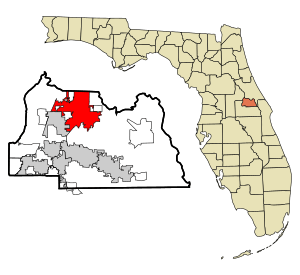
Location in Seminole County and the U.S. state of Florida
|
|||
| Country | United States | ||
| State | Florida | ||
| County | Seminole | ||
| Incorporated | September 29, 1877 | ||
| Founded by | Henry Shelton Sanford | ||
| Government | |||
| • Type | Commission–Manager | ||
| Area | |||
| • City | 27.18 sq mi (70.39 km2) | ||
| • Land | 23.58 sq mi (61.07 km2) | ||
| • Water | 3.60 sq mi (9.32 km2) | ||
| Elevation | 39 ft (12 m) | ||
| Population
(2020)
|
|||
| • City | 61,051 | ||
| • Density | 2,589.21/sq mi (999.68/km2) | ||
| • Urban | 1,510,516 (32nd U.S.) | ||
| • Metro | 2,267,846 (26th U.S.) | ||
| Time zone | UTC-5 (EST) | ||
| • Summer (DST) | UTC-4 (EDT) | ||
| ZIP codes |
32771, 32773
|
||
| Area code(s) | 321, 407, 689 | ||
| FIPS code | 12-63650 | ||
| GNIS feature ID | 2405418 | ||
Sanford is a city in Florida, located in the middle of the state. It is the main city of Seminole County, Florida. In 2020, about 61,051 people lived there. Sanford is part of the larger Orlando area.
Sanford is known as the "Historic Waterfront Gateway City." It sits on the southern shore of Lake Monroe. This lake is at the start of the St. Johns River, which is a major waterway. Native Americans lived here thousands of years ago. The Seminole people arrived in the 1700s.
During a conflict called the Second Seminole War in 1836, the United States Army built a camp here. This camp was called Camp Monroe. Sanford is about 20 miles (32 km) northeast of Orlando.
Today, Sanford is home to Seminole State College of Florida and the Central Florida Zoo and Botanical Gardens. Its downtown area is popular with visitors. It has shops, restaurants, a marina, and a walking path along the lake. The Orlando Sanford International Airport is also in the city. It serves as a second airport for flights in and out of the Orlando area.
Contents
Sanford's Story: A Look Back
Early Days and Native People
Long ago, the Mayaca and Jororo Indians lived by Lake Monroe. By 1760, many of them were gone due to wars and sickness. The Seminole Indians then moved into the area.
In 1821, the United States took control of Florida from Spain. But conflicts with the Seminoles, called the Seminole Wars, slowed down new settlements. In 1835, the Seminoles burned a port city called Palatka. This city was important for travel on the St. Johns River.
Because of this, the army set up a base near Lake Monroe in 1836. It was called Camp Monroe. The camp was attacked by Indians in 1837. It was then made stronger and renamed Fort Mellon. This was to honor Captain Charles Mellon, who died in the attack.
A general named Zachary Taylor built a road connecting Fort Mellon to other forts. In 1842, a town called Mellonville grew up around Fort Mellon. In 1845, Florida became a U.S. state. Mellonville became the main city for Orange County. People started planting orange groves. The first orange packing plant was built in 1869.
How Sanford Began
In 1870, a man named "General" Henry Shelton Sanford bought a large area of land. It was west of Mellonville. He planned out the community of Sanford. He believed it would become a major travel center. He called it "The Gateway City to South Florida."
Sanford brought about 150 Swedish people to work there. They helped clear the land and build the new town. They arrived by steamboat in 1871.
Sanford became an official town in 1877 with 100 people. In 1883, it joined with Mellonville. That same year, President Chester A. Arthur visited Sanford for a vacation.
Sanford also became a center for trains. New train lines connected Sanford to Orlando, Tampa, and Jacksonville. This made it easy to move goods. Soon, the area became the biggest shipper of oranges in the world.
In 1887, a big fire damaged the city. The next year, a sickness called yellow fever spread. Then, in 1894 and 1895, a "Great Freeze" destroyed the orange crops. Farmers then started growing other vegetables. Celery was first planted in 1896. This is why Sanford is known as the "Celery City."
In 1891, a nearby African American community called Goldsboro became its own town.
The first public library in Sanford was started in 1878 by Mrs. Henry Sanford. It had a few books and a librarian. Later, in 1889, women from the Wednesday Club worked to restart the library. They raised money and had a small library in a storefront. The library moved a few times and grew. In 1924, an official Public Library opened on 5th Street, supported by the city.
Sanford in the 1900s
In 1911, a part of Sanford called Sanford Heights wanted to separate from the city. This caused problems because Sanford wanted to grow. A former mayor, Forrest Lake, worked to combine Sanford and Goldsboro. On April 26, 1911, a new law was passed. It made Sanford a bigger city that included Goldsboro.
In 1913, Sanford became the main city of Seminole County. Farming was very important until 1940. After that, it became cheaper to grow crops in South Florida.
In 1942, during World War II, a naval air base was built in Sanford. It was called Naval Air Station Sanford. Pilots were trained there to fly different types of planes. At its busiest, from 1943 to 1945, the base had about 360 officers and 1,500 enlisted men. It also had 150 women from the WAVES (Women Accepted for Volunteer Emergency Service).
The base closed in 1946 but reopened in 1950 because of the Korean War and the Cold War. It was made into a large base for jet planes. In the mid-1960s, nearly 4,000 military people lived there. They flew planes like the Douglas A-3 Skywarrior and North American A-5 Vigilante. These planes were used in the Vietnam War.
In 1967, the base was chosen to close. This was due to the high costs of the Vietnam War. When the military people and their families left, it caused problems for Sanford's economy. In 1969, the airfield was given to the City of Sanford. It became a general airport, then the Central Florida Regional Airport. In 1995, it started having commercial flights. The next year, it was renamed Orlando Sanford International Airport. Today, a special park and a restored plane at the airport remember the Navy's time there.
Tourism and Growth
When Walt Disney World Resort opened in 1971, it changed Central Florida's economy. It shifted from farming and military bases to tourism. Orlando became the center of this growth. But Sanford still has many old buildings and tree-lined streets. Its location on Lake Monroe and the St. Johns River makes it a popular place for boats. Many marinas are there, allowing boats to travel to the Atlantic Ocean.
Jackie Robinson's Visit
Sanford Field, built in 1926, was a special place in baseball history. In 1946, Jackie Robinson came to Florida for spring training. He was going to play for the Montreal Royals, a team connected to the Brooklyn Dodgers. This was important because Robinson was the first African American player to join a racially mixed baseball team.
Florida at that time had strict rules about segregation. Robinson could not stay in the same hotel as his white teammates. Many towns would not let his team play if he was on the roster. The police chief in Sanford even threatened to stop the game if Robinson played.
Robinson still came to the field. But the crowd, mostly white, caused a big fuss. He was taken off the field and could not play. This event showed the challenges he faced in breaking down racial barriers in sports.
Historic Sanford Memorial Stadium was built in 1951 near the old field. It was used for spring training by the New York Giants. Many famous baseball players have played in Sanford, including Babe Ruth, Willie Mays, Tim Raines, and David Eckstein.
Sanford Today: The 21st Century
Since 2004, Sanford has worked to improve its downtown area. The city wanted to attract new businesses and visitors. By 2016, downtown Sanford became known for its craft beer. It has several small breweries and pubs.
Sanford's Location
Sanford is located at about 28°47′21″N 81°16′33″W.
The city covers about 26.5 square miles (68.6 km²). About 22.96 square miles (59.5 km²) is land, and 3.54 square miles (9.2 km²) is water. Sanford is next to Lake Mary to the southwest. To the north, it is bordered by Lake Monroe and DeBary.
Weather in Sanford
Like the rest of Central Florida, Sanford has a warm, wet climate. Winters are dry and warm, while summers are hot and wet. The dry season is from October to May. The wet season is from June to September.
| Climate data for Sanford, Florida (Orlando Sanford International Airport), 1991–2020 normals, extremes 1948–present | |||||||||||||
|---|---|---|---|---|---|---|---|---|---|---|---|---|---|
| Month | Jan | Feb | Mar | Apr | May | Jun | Jul | Aug | Sep | Oct | Nov | Dec | Year |
| Record high °F (°C) | 89 (32) |
89 (32) |
94 (34) |
97 (36) |
100 (38) |
102 (39) |
103 (39) |
100 (38) |
97 (36) |
95 (35) |
92 (33) |
89 (32) |
103 (39) |
| Mean maximum °F (°C) | 83.2 (28.4) |
85.3 (29.6) |
88.3 (31.3) |
91.4 (33.0) |
95.3 (35.2) |
96.8 (36.0) |
96.8 (36.0) |
96.7 (35.9) |
94.4 (34.7) |
91.0 (32.8) |
87.1 (30.6) |
83.9 (28.8) |
98.2 (36.8) |
| Mean daily maximum °F (°C) | 71.3 (21.8) |
74.2 (23.4) |
78.3 (25.7) |
83.4 (28.6) |
88.5 (31.4) |
91.0 (32.8) |
92.7 (33.7) |
92.5 (33.6) |
89.7 (32.1) |
84.6 (29.2) |
78.2 (25.7) |
73.4 (23.0) |
83.1 (28.4) |
| Daily mean °F (°C) | 60.4 (15.8) |
63.1 (17.3) |
67.1 (19.5) |
72.3 (22.4) |
77.7 (25.4) |
81.9 (27.7) |
83.6 (28.7) |
83.6 (28.7) |
81.4 (27.4) |
75.5 (24.2) |
68.2 (20.1) |
63.1 (17.3) |
73.2 (22.9) |
| Mean daily minimum °F (°C) | 49.6 (9.8) |
52.1 (11.2) |
55.9 (13.3) |
61.2 (16.2) |
67.0 (19.4) |
72.7 (22.6) |
74.4 (23.6) |
74.6 (23.7) |
73.1 (22.8) |
66.5 (19.2) |
58.2 (14.6) |
52.7 (11.5) |
63.2 (17.3) |
| Mean minimum °F (°C) | 32.4 (0.2) |
35.6 (2.0) |
40.2 (4.6) |
47.6 (8.7) |
56.6 (13.7) |
66.7 (19.3) |
70.1 (21.2) |
70.5 (21.4) |
67.2 (19.6) |
52.8 (11.6) |
43.4 (6.3) |
36.4 (2.4) |
30.2 (−1.0) |
| Record low °F (°C) | 19 (−7) |
25 (−4) |
27 (−3) |
36 (2) |
45 (7) |
52 (11) |
60 (16) |
64 (18) |
52 (11) |
39 (4) |
27 (−3) |
19 (−7) |
19 (−7) |
| Average precipitation inches (mm) | 2.36 (60) |
2.25 (57) |
2.85 (72) |
2.35 (60) |
3.31 (84) |
8.19 (208) |
7.29 (185) |
6.77 (172) |
6.24 (158) |
3.90 (99) |
1.88 (48) |
2.24 (57) |
49.63 (1,261) |
| Average precipitation days (≥ 0.01 in) | 8.1 | 8.0 | 7.9 | 7.1 | 8.3 | 17.0 | 16.7 | 17.2 | 15.7 | 9.9 | 8.4 | 8.3 | 132.6 |
| Source: NOAA | |||||||||||||
People in Sanford
| Historical population | |||
|---|---|---|---|
| Census | Pop. | %± | |
| 1890 | 2,016 | — | |
| 1900 | 1,450 | −28.1% | |
| 1910 | 3,570 | 146.2% | |
| 1920 | 5,588 | 56.5% | |
| 1930 | 10,100 | 80.7% | |
| 1940 | 10,217 | 1.2% | |
| 1950 | 11,935 | 16.8% | |
| 1960 | 19,175 | 60.7% | |
| 1970 | 17,393 | −9.3% | |
| 1980 | 23,176 | 33.2% | |
| 1990 | 32,387 | 39.7% | |
| 2000 | 38,291 | 18.2% | |
| 2010 | 53,570 | 39.9% | |
| 2020 | 61,051 | 14.0% | |
| 2022 (est.) | 63,154 | 17.9% | |
| U.S. Decennial Census | |||
| Race | Pop 2010 | Pop 2020 | % 2010 | % 2020 |
|---|---|---|---|---|
| White (NH) | 24,096 | 22,437 | 44.98% | 36.75% |
| Black or African American (NH) | 15,660 | 15,495 | 29.23% | 25.38% |
| Native American or Alaska Native (NH) | 204 | 138 | 0.38% | 0.23% |
| Asian (NH) | 1,473 | 3,031 | 2.75% | 4.96% |
| Pacific Islander or Native Hawaiian (NH) | 22 | 33 | 0.04% | 0.05% |
| Some other race (NH) | 198 | 415 | 0.37% | 0.68% |
| Two or more races/Multiracial (NH) | 1,073 | 2,672 | 2.00% | 4.38% |
| Hispanic or Latino (any race) | 10,844 | 16,830 | 20.24% | 27.57% |
| Total | 53,570 | 61,051 |
In 2020, Sanford had 61,051 people living in 22,236 households. There were 14,084 families. On average, there were 2.66 people per household.
About 6.4% of the population was under 5 years old. 23.3% were under 18 years old. And 12.4% were 65 years or older. About 49.2% of the people were female.
The average value of homes owned by people was $196,100 in 2020. The average rent was $1,255. Most households (94.7%) had a computer. Also, 86.9% had high-speed internet.
In 2020, 89.3% of people aged 25 and older had finished high school. And 25.9% of those people had a college degree or higher.
Getting Around Sanford
Air Travel
The Orlando Sanford International Airport (SFB) offers flights for people traveling to and from Central Florida. In 2017, about 2.9 million passengers used this airport.
Biking Paths
Sanford's Riverwalk is a great place to bike, walk, or run. It follows Lake Monroe and goes through downtown Sanford. This path will soon connect to a larger network of trails across Florida. This network will link the west and east coasts of Central Florida.
Bus Services
Sanford has several Lynx bus routes. These buses go to different places like historic downtown, Seminole State College, the Sanford SunRail Station, and the Seminole Towne Center mall.
Train Travel
Sanford is the southern end of Amtrak's Auto Train. This train carries travelers and their cars to Lorton, Virginia. Lorton is about 25 miles (40 km) south of Washington, D.C.. Other Amtrak stations for passengers without cars are nearby in Winter Park and Deland.
SunRail is Central Florida's commuter train system. It serves Sanford from a new station near State Road 46. A new trolley bus connects the SunRail station to the historic downtown.
Roads and Highways
Sanford is close to the northern part of the I-4 Corridor. This highway runs between Daytona Beach and Orlando. The State Road 417, also called the Seminole Expressway, starts in Sanford at Interstate 4. It forms an eastern loop around Orlando and ends near Walt Disney World Resort.
Main Roads
 I-4
I-4
 US 17 / US 92 (French Avenue)
US 17 / US 92 (French Avenue) SR 417 (Seminole Expressway)
SR 417 (Seminole Expressway) SR 46 (25th Street)
SR 46 (25th Street) CR 46A (H.E. Thomas Jr Parkway)
CR 46A (H.E. Thomas Jr Parkway)
Waterways
In the past, Sanford was a major port on the St. Johns River. It was a key place for transportation in Central Florida. Today, it has a marina in downtown. This marina offers free short-term docking for boaters visiting the area.
Learning in Sanford
The public schools in Sanford are part of Seminole County Public Schools.
Colleges
- Seminole State College of Florida
High Schools
- Crooms Academy of Information Technology
- Seminole High School
Middle Schools
- Millennium Middle School
- Sanford Middle School
Elementary Schools
- All Souls Catholic School (Kindergarten to 8th grade)
- Bentley Elementary School
- Galileo School for Gifted Learning (Kindergarten to 8th grade)
- Goldsboro Elementary Magnet School
- Hamilton Elementary School of Engineering & Technology
- Idyllwilde Elementary Future Ready Academy
- Midway Elementary School of the Arts
- Pine Crest Elementary School of Innovation
- Wicklow Elementary School for Global Pathways
- Wilson Elementary School
Sanford's Public Library
Sanford has a public library called the North Branch Library. It is part of the Seminole County Public Library system. You can find it at 150 N. Palmetto Avenue, Sanford, Florida 32771.
Fun Things to Do in Sanford
- The Central Florida Zoo and Botanical Gardens
- Local Parks
- Fort Mellon Park
- The Paw Park Sanford
- Park on Park
- The Wayne Densch performing arts center
- Annual Oktoberfest (second weekend of October)
- Alive After Five (Second Thursday of every month in downtown)
- Sanford Museum
- Central Florida Soapbox Derby
- Historic Sanford Memorial Stadium
- Theater West End
City Projects and Improvements
The city's RiverWalk trail was finished in 2004. It's a wide paved path for biking, walking, and running. It stretches for several miles along the waterfront of Lake Monroe in downtown Sanford. More parts of the trail were added in 2014, and more are planned.
Sanford has also spent millions of dollars to improve its historic downtown streets. They added brick paths, wider sidewalks, trees, flowers, and benches.
Sanford is connected to the SunRail commuter train system. The train station is about 2 miles (3.2 km) from downtown.
To help the environment, Sanford has added five electric car charging stations. The city is also planning to change streetlights to energy-saving LED lights.
In 2012, the city started "Imagine Sanford." This project asks all Sanford residents to share their ideas for improving the city. They can submit and vote on ideas through the city's website. The city also launched a new government website in 2012.
Famous People From Sanford
- Raul Aguilera (born 1999) – soccer player
- Ray-Ray Armstrong (born 1991) – National Football League (NFL) player
- Red Barber (1908–1992) – Major League Baseball (MLB) sports commentator
- Zinn Beck (1885–1981) – MLB player
- Jeff Blake (born 1970) – NFL player
- Reggie Branch (born 1962) – NFL player
- Alwyn Cashe (1970–2005) – U.S. Army sergeant first class who received the Medal of Honor
- Jim Courier (born 1970) – tennis player
- Gabe Davis (born 1999) – NFL player
- David Eckstein (born 1975) – MLB player
- Rick Eckstein (born 1973) – MLB hitting coach
- Trinity Fatu (born 1987) – professional wrestler
- Elvira Garner (1886–1956) – author and illustrator
- Joseph C. Hutchinson (1894–1982) – U.S. Army lieutenant general
- Logan Misuraca (born 1999) – stock car racer
- Tim Raines (born 1959) – MLB player and coach
- Marty Raybon (born 1959) – singer and co-founder of the Shenandoah and Raybon Brothers bands
- Bill Swaggerty (born 1956) – MLB player
- Mary Lou Zoback (born 1952) – geophysicist and seismologist
Images for kids
See also
 In Spanish: Sanford (Florida) para niños
In Spanish: Sanford (Florida) para niños



